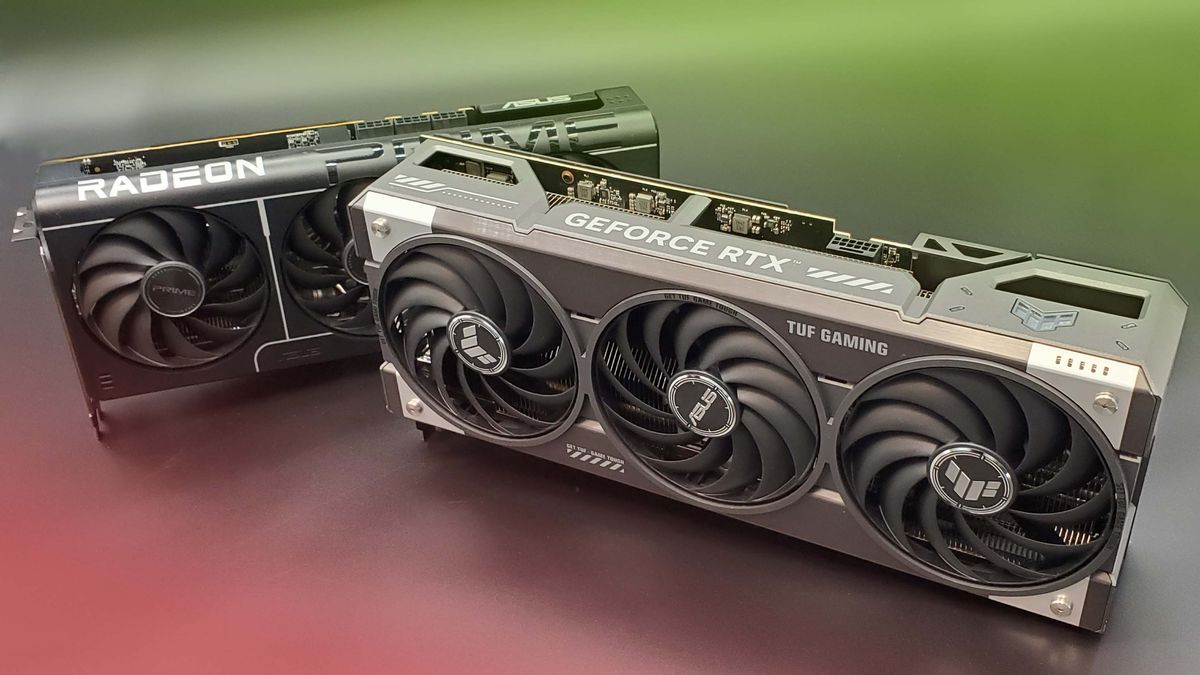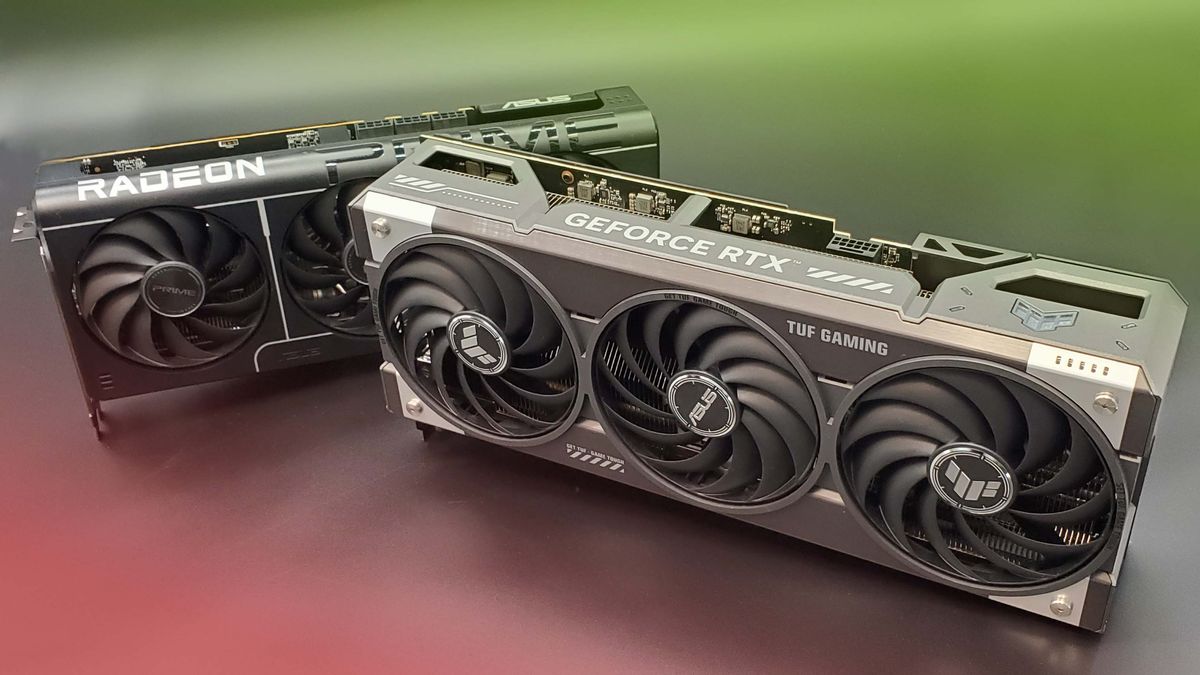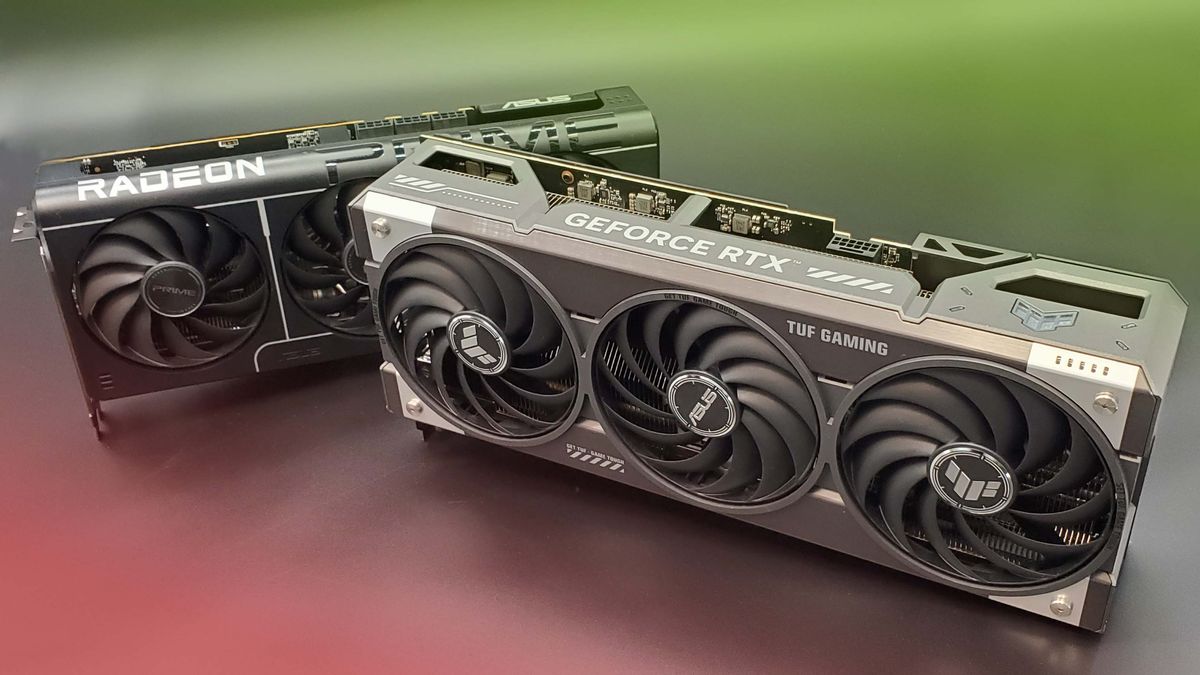AMD RX 9070 XT vs Nvidia RTX 5070 Ti: This is 2025's graphics card battle royale
AMD RX 9070 XT vs Nvidia RTX 5070 Ti: This is 2025's graphics card battle royale

Picking between the RX 9070 XT and the RTX 5070 Ti is a lot harder today than it was when I first reviewed the two graphics cards

It feels like it's been a long time since we last had a genuine graphics card showdown between AMD and Nvidia. But here we are in 2025 and the Radeon RX 9070 XT is showing itself a true competitor to Nvidia's RTX 5070 Ti, and that's a GPU which is nominally far more expensive.
The green team has had it largely its own way for the past few generations, with the red side of the GPU divide only really able to compete if you take ray tracing and upscaling features out of the equation.
Look back to the RTX 40-series vs. the RX 7000-series, and AMD itself will tell you that the only cards that were particularly well received were its more affordable RX 7800 XT and RX 7700 cards. And they were largely fighting on price, and maybe a little on performance and some VRAM numbers.
This time around, while AMD's latest GPU is theoretically considerably cheaper than its Nvidia rival, it's not just about the price. That's become evident where scarcity has pushed them far closer together and there is still a lot of positive feeling towards the Radeon card. The price/performance numbers are seriously impressive right now, and not just with the usual caveats.
With the RX 9070 XT AMD has closed the gap on ray tracing performance, has upped its upscaling game, and is giving Nvidia a tough time. But the RTX 5070 Ti definitely has some aces up its sleeve and there are some very key points where the GeForce crew can point to huge frame rate leads, so as the price gap tightens, who should come out on top?
AMD RX 9070 XT vs Nvidia RTX 5070 Ti: Specs
(Image credit: Future)
As far as a head-to-head goes, in specs terms things are pretty darned close between the two cards. They both sport their respective manufacturers' latest GPU architecture—on the AMD side that's RDNA 4 and on the Nvidia it's the RTX Blackwell arch—and both contain very much mid-range graphics silicon.
They're also relatively close in terms of the raw GPU specs. The chips themselves are very similar in size—365.5 mm2 against 378 mm2—and contain a whole lot of nominally 4 nm transistors, too. There does seem to be a large disparity between their relative shader counts, but it's this spec in particular where it's impossible to truthfully do an apples to apples comparison. They are very different fruits, even if they deliver roughly the same end result.
There is also a clear divide between their rated boost clock speeds, too. Though, again, this is more of an on-paper distinction because in practice I've seen the RX 9070 XT and RTX 5070 Ti cards I've been testing both hovering around the 2,600 - 2,700 MHz mark, so essentially it's a level playing field on that front.
Memory is probably the part which has the biggest disparity, but only in terms of raw memory bandwidth. They're both running on a 256-bit memory bus, and they're both sporting 16 GB of video memory, but the RTX 5070 Ti comes with GDDR7 memory running at 28 Gbps, while the RX 9070 XT is using the older GDDR6 20 Gbps VRAM. That means there's 40% more memory bandwidth available to the Nvidia chip. In general, this makes the GeForce GPU better suited to high resolution gaming.
Then there's the power draw. Both the cards are sitting around the 300 W mark, with the RTX 5070 Ti coming in at 285 W and the RX 9070 XT with a TBP of 304 W. Though, again the reality is a little different in practice, with the average power draw of the two cards actually coming out at 303 W and 352 W respectively.
AMD RX 9070 XT vs Nvidia RTX 5070 Ti: Price
The relative pricing of the two cards should be the key point in this whole head-to-head, but such is the state of PC gaming hardware in 2025 that the actual on-shelf pricing of the RX 9070 XT and RTX 5070 Ti right now are disturbingly similar.
Disturbing, because they should be miles apart. The MSRP for the RTX 5070 Ti is $750, which is already a lot for a mid-range GPU, while the RX 9070 XT launched with a $599 MSRP that should have taken the Nvidia competitor out at the knees. With a $150 price delta, and nothing in it in terms of specs, it would be tough indeed to come down on the side of the Nvidia GPU.
And that might indeed be the situation in the future when stock will hopefully normalise and pricing trends down towards MSRP for both cards.
That is a heavy might , however, because manufacturers I spoke to admitted AMD's MSRP for the RX 9070 XT was only ever meant to be a launch price and that the card partners had always planned to hike prices the instant release day was done. So, whether we'll actually see any $599 RX 9070 XT cards in the future is looking pretty unlikely.
To be fair, the same can be said regarding the RTX 5070 Ti, as the scarcity of RTX 50-series GPUs in the retail market means that prices remain ludicrously high, and it's going to be a long time before prices come down. Again, I would be surprised to see that $750 MSRP being achieved at any point this year.
Right now, in the Spring of 2025, the best pricing in the US is over at Amazon where it's locking them behind Prime member deals. Though the best prices do have the RX 9070 XT higher than the original $750 MSRP for the RTX 5070 Ti, which in turn is $900. For Prime members, then, the $150 price delta remains, but for everyone else we're looking at $900+ price tags for both cards.
For the UK, things are definitely a bit better, though the RX 9070 XT is still well above MSRP, while the RTX 5070 Ti can be had for very close to, or at its own MSRP. Either way, things are essentially almost level pegging when it comes to real-world pricing right now.
AMD RX 9070 XT vs Nvidia RTX 5070 Ti: Performance
(Image credit: Future)
This is the really important part of the conversation, because the relative pricing of the two cards means nothing if the gaming performance isn't there. But, thankfully for AMD, it absolutely is. The new RDNA 4 GPUs have been purpose built for a price-to-performance ratio that really takes the fight to Nvidia, and that's what they do.
AMD has also filled in the gaps where the Radeon GPUs of architectures past have fallen down compared with the GeForce alternative. And that means the ray tracing performance of the RX 9070 XT has been hugely improved and we're now seeing the first shoots of machine learning being brought into AMD FidelityFX Super Resolution (FSR) upscaler with the new 4.0 version.
In pure, native performance terms it's only really the super heavy ray tracing of Cyberpunk 2077 that causes any big delta in gaming performance at 4K or 1440p. Otherwise there are barely a handful of frames per second in it. And even that big difference starts to fade once we start talking about the real-world performance which brings in upscaling and frame generation.
If we're just mixing in standard 2x frame generation for both cards, and a DLSS or FSR Quality setting, then even Cyberpunk 2077 is a level race. In fact, the AMD card comes out ahead in that and F1 24, which both use a bunch of ray tracing effects.
That is just on the raw number side of things, however, and it is important to note that while AMD does have FSR 4 now running on machine learning algorithms, there are still precious few games which support it. That means, with Cyberpunk 2077 and F1 24, those numbers are all using the original FSR 3 and frame generation features which definitely don't have the visual quality of Nvidia's competing DLSS and more advanced Frame Generation tech.
In terms of image quality alone, Nvidia's upscaling and interpolating technology is still in advance of AMD's. And that's before we get into the real magic trick of the RTX Blackwell generation GPUs: Multi Frame Generation.
Not just a clever name, MFG is literally just the same feature but instead of adding in one extra AI generated frame in between each actually rendered one, the RTX 50-series cards are now able to generate up to three additional frames. This inevitably brings up the debate about fake frames and whether this is actually just frame smoothing, but the end result is a game that, no matter how you feel about what those resulting fps metrics say, feels smoother and faster than without it.
At the extremes, when the input frame rate is very low to start with, pushing to 4x MFG does add a ton of extra latency into games and that can make it feel sluggish even if the frame rate is presented as high. But, if the DLSS performance is delivering near 60 fps, then Multi Frame Generation can make a huge difference to the feel of a game.
The issue is that, like FSR 4, it is not in every game on the market. Unlike FSR 4, however, it is easily back-ported into games with existing Frame Gen support—though notably hasn't been ported into all of them—and there's a good chance that every big game release of the next year that comes with Nvidia's Frame Gen tech will come with MFG as standard.
[Content truncated due to length...]
From PCGamer latest via this RSS feed
